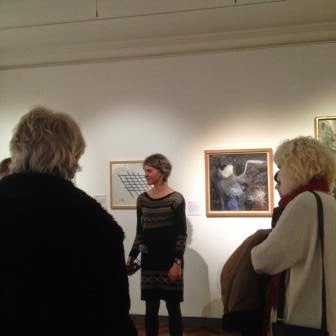I am very grateful to Jane Milner-Barry for her superb writing, which is featured below, on Sasha Ward and Kelmscott To hear about the residency from Sasha Ward herself, come along to the Swindon Museum and Art gallery on Thursday 26 March for a 7.30pm start. Tickets £5 and £4 to Friends.
100 years on, Morris’s Kelmscott still
inspires artists and visitors
William
Morris, artist, writer, manufacturer and utopian socialist, died in 1896. But
his overcoat is still hanging behind a door in the entrance hall at Kelmscott
Manor. For many years Morris rented the
beautiful old house, over the Thames from Buscot, as a retreat for himself, his
wife Janey and their daughters Jenny and May.
They loved to escape to Kelmscott from their busy life in London. The well-worn coat was one of the many
evocative objects that caught Sasha Ward’s eye when she arrived at Kelmscott in
May 2014 as the first Artist in Residence.
“The house is full of personal belongings, and fabrics embroidered by
Janey and May” says Sasha. “And there
are places you recognise from Morris’s letters.
It can be quite spooky sometimes”.
The opportunity
to spend the summer as Artist in Residence at Kelmscott attracted a great deal
of interest and the trustees chose stained glass artist Sasha from 150 applicants,
all artists of standing. “I was thrilled
to be picked” says Sasha. “Of course I share William Morris’s obsession with
stained glass. But also I loved the idea
of being part of the life of Kelmscott.
It’s an incredibly busy place with up to 500 visitors a day.”
Sasha fell in
love with stained glass as a teenager, when three friends visiting Chartres
Cathedral sent her postcards of the windows.
She lives in Marlborough, where she has a studio and the all-important
kiln in which she can fire sheets of glass up to a metre wide and two metres
long.
Sasha has completed over 70 projects and
commissions in the UK and abroad, including a window for the Chaplaincy at Swindon’s
Great Western Hospital. She likes to
work on a grand scale and her biggest commission to date has been a dramatic
stairwell window for the Premier Inn in Liverpool, which comprises eighty
square metres of glass. “But I’d love to
work on an even bigger scale” says Sasha.
“Maybe a project for a cathedral . . . ”
At Kelmscott,
Sasha set up a workshop in the Brewhouse.
There she worked on a series of
small stained glass panels, explaining the process to the visitors and
encouraging them to take part. One
project was inspired by a window pane on which May Morris and her friends had
scratched their names. Sasha invited people
to sign their names on scraps of glass with a diamond-tipped pen, and assembled
the pieces – bearing 103 signatures - into
a window which has now been installed at Kelmscott. Visiting children were given pencils and
paper and encouraged to draw things that appealed to them, and there were
workshops for adults and children. A tiny “box cottage” belonging to May Morris is
on show at Kelmscott; it was discovered in one of the attics. Now the visitors made “stained glass” windows
and block-printed wallpaper, and used them to turn cardboard play-houses into richly
patterned Arts and Crafts residences. Polystyrene
tiles made excellent wallpaper blocks!
For the
second year running, Kelmscott Manor has been shortlisted for the title of
“Most Inspiring Heritage Attraction”.
The house is currently closed for the winter but will be open to the
public on Wednesdays and Saturdays from the beginning of April.
Here is a copy of the poster, much higher resolution ones are available:
Here's the massive kiln:
Below some glass in Sasha's studio:
Above Sasha's drawing of Kelmscott Manor, and below a child's drawing inspired by a William Morris peacock:
Sasha's drawing of the WM overcoat still on the back of the door!
Below a model of Kelmscott house:
And the lovely Swindon Advertiser article:
Tickets for the talk can be reserved by ringing the Museum on 01793 466556, from the Museum during opening hours Wed-Sat 11am-3pm, or turn up from 7pm on the night.









































